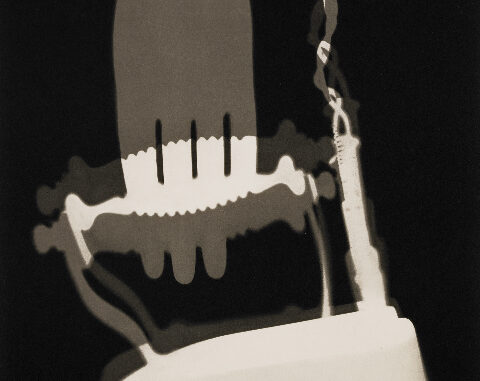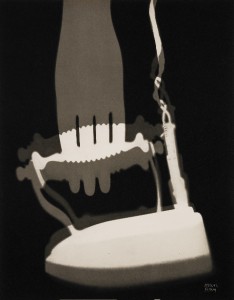

The popular conception of photography today is of an instantaneous, digital medium, enjoyed by the everyman and driven by the number of megapixels our cameras can produce allied with intuitive software, boasting features such as multi-point focus and face recognition. All but the most basic of mobile phones sport a camera with a tiny lens peering out, ready to capture the events of the day. Cameras have become ubiquitous. The aesthetic of photography has de facto become one centred upon the lens. The concept of the camera as a capture device that traps light, focuses it through a lens and exposes it to an image – traditionally onto film but now, a sensor – predominates.
Whilst the serious photography aficionado will often succumb to gadget fetishes and get sucked into a technological race, chasing increasing pixel resolution and exponentially more powerful image sensors the intriguing discipline of Camera-less Photography calls this expensive and insatiable pursuit into question. Why? Because photography’s heritage lies in light eliciting chemical reactions on film and paper and due to the chemical properties of these media, light and other energy forms, such as X-rays and Ultraviolet (UV) radiation can produce stunning, offbeat and unique images without any need for a camera.
At the birth of the medium the pioneering calotype process of Fox Talbot used photosensitive silver preparations administered to paper to create images that amazed society in his landmark collection The Pencil of Nature. His studies of the window at Lacock Abbey were produced with experimental equipment in 1835 and have been paid homage to and reworked by photogram artist Floris Neususs who created a life-size photogram of the same window.
Contemporary with the calotype, the cyanotype process pioneered by Sir John Herschel was of a particular fascination to a young protégé of his, Anna Atkins who saw the potential of the blue treated papers as a far more accurate means of illustrating studies and taxonomies of the flora of the British Isles that were her life’s work. She learnt the chemical process for treating the papers from Herschel and was able to lay botanical subjects directly onto her sensitive ‘films’ and leave them to be exposed by natural light from the sun. Her captivating and ethereal blue pictures were intended to be documentary and descriptive in nature but achieve a transcendent allure earning her general recognition as the first female photographer.
As photo papers and chemical processing techniques progressed and photography became established and widely consumed, artists such as Man Ray and Lazlo Moholy-Nagy were inspired to use photographic papers directly, without cameras to create photograms. Exposing objects directly to negatives or photo-papers, their 20th century Constructivist, Surrealist and Dadaist experiments were obsessed with the moment of origination of the image, its uniqueness and freedom from mass reproducibility. This was unlike the realist or journalistic experiences of contemporaries such as Cartier-Bresson and his Magnum agency or the photographers shooting for Life Magazine. The compact camera and celluloid negative meant reproducibility, easy transfer to the print press and transmission on wire services. In contrast photograms were closer to painting or sculpture and embodied transience and chance. Moholy-Nagy coined the term “the New Vision” for his belief that photography could create a whole new way of perceiving the outside world that the human eye could not.
By the mid 20th century most layman’s notion of photography as a medium was demonstrated in the pages of Life or National Geographic but artists and photographers wholeheartedly began to explore the newer photo-papers, colour processes and films and fervently to challenge the assumption that we need a camera to create a photograph. Experimental, beatnik and counterculture artists were at the vanguard, like Bruce Conner with his Angels series of anatomical, figurative photograms which showed the body in an eerie, ghostly manner prompting relations with liminal states between life and death, burial shrouds and religious iconography and evoking associations with arguably the oldest photogram: The Turin Shroud. Conner’s friend and collaborator Stan Brakhage experimented with moving photograms, camera-less movie films and directly manipulating celluloid. Facets of his work are today seen in Hollywood movies, with Director David Fincher citing Brakhage as an influence.
An artist who radically re-examined the aesthetics of photography, Robert Heinecken forged a role as ‘Para-Photographer’. Essentially, the artist decided that in the wake of the media explosion that had come to characterise contemporary life, enough photographs already existed. Because Heinecken’s work subverted the conventions of photography and image reproduction he was dubbed a Photographist. A term he favoured.
Adam Fuss is a contemporary practitioner of camera-less photography and his work formed a part of a unique exhibition of the art form last year at the V&A – entitled Shadowcatchers. Fuss feels a photogram has much less information but much more intimacy and feeling than a photograph. His series My Ghosts (1999) suggests Victorian spirit photography: a glimpsed human figure amid a funereal column of smoke; a christening dress devoid of its wearer, as if preserved by grieving parents and Daguerrotypes of exotic, diaphanous butterflies.
So before you ask for the latest bells and whistles kit from Canon, Nikon or Sony this Christmas, put your cameraphone away too and go and source some old film, chemicals and paper stocks from the bargain bins of your local camera shop. Find a dark recess in an attic, garage or shed and get exposed to the enthralling art of camera-less photography.

Hi,
I really like that someone points out the camera less photography. The focus on a playful attitude in photography without a lens is a cool focus, I can agree on. A playful manner towards taking pictures is what makes iPhoneography great and that the same is possible in other ways, just with paper only, inspires me. Do you know any good basic tutorials?
Cheers
Hi Moritz,
Thanks for the positive comments about my article. A playful attitude and relying on chance when making photographs is great fun and so different from all the digital apps we have come to rely on.
A good tutorial which describes how to make photograms is here:
https://www.ephotozine.com/article/making-a-photogram—traditional-darkroom-ideas-4688
If you want a good practical introduction to making photographic images without a camera, Camberwell College of Art in London are running a course entitled The Art of Camera-less Photography on 16 and 17 July 2012. You need to bring along a few items with you and there is a fee but this would be a good starter to making photographic art.